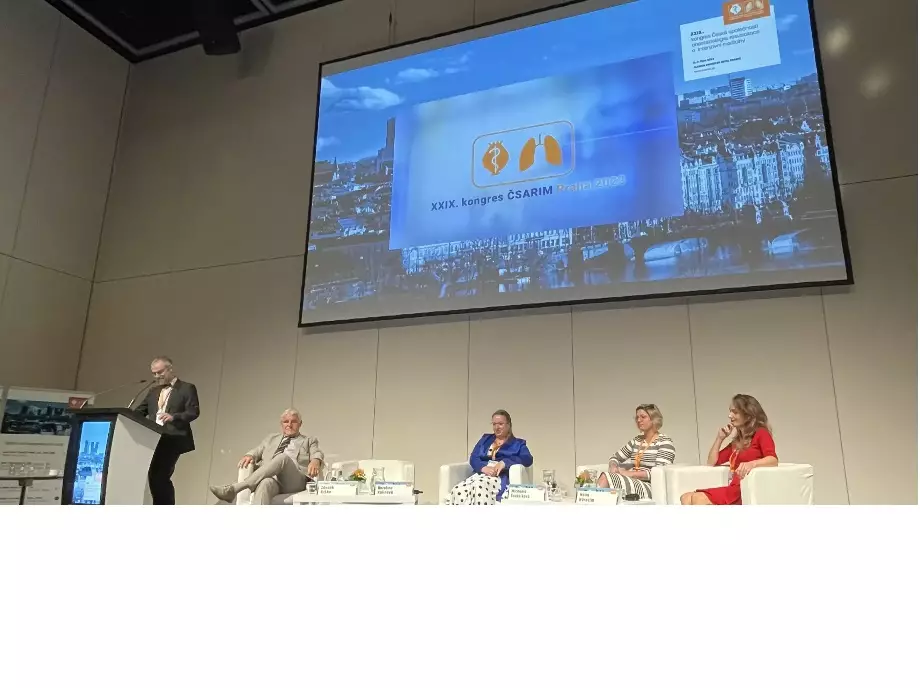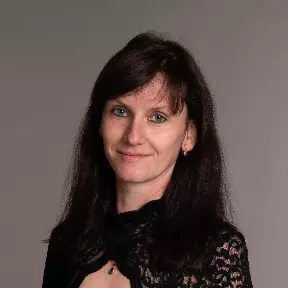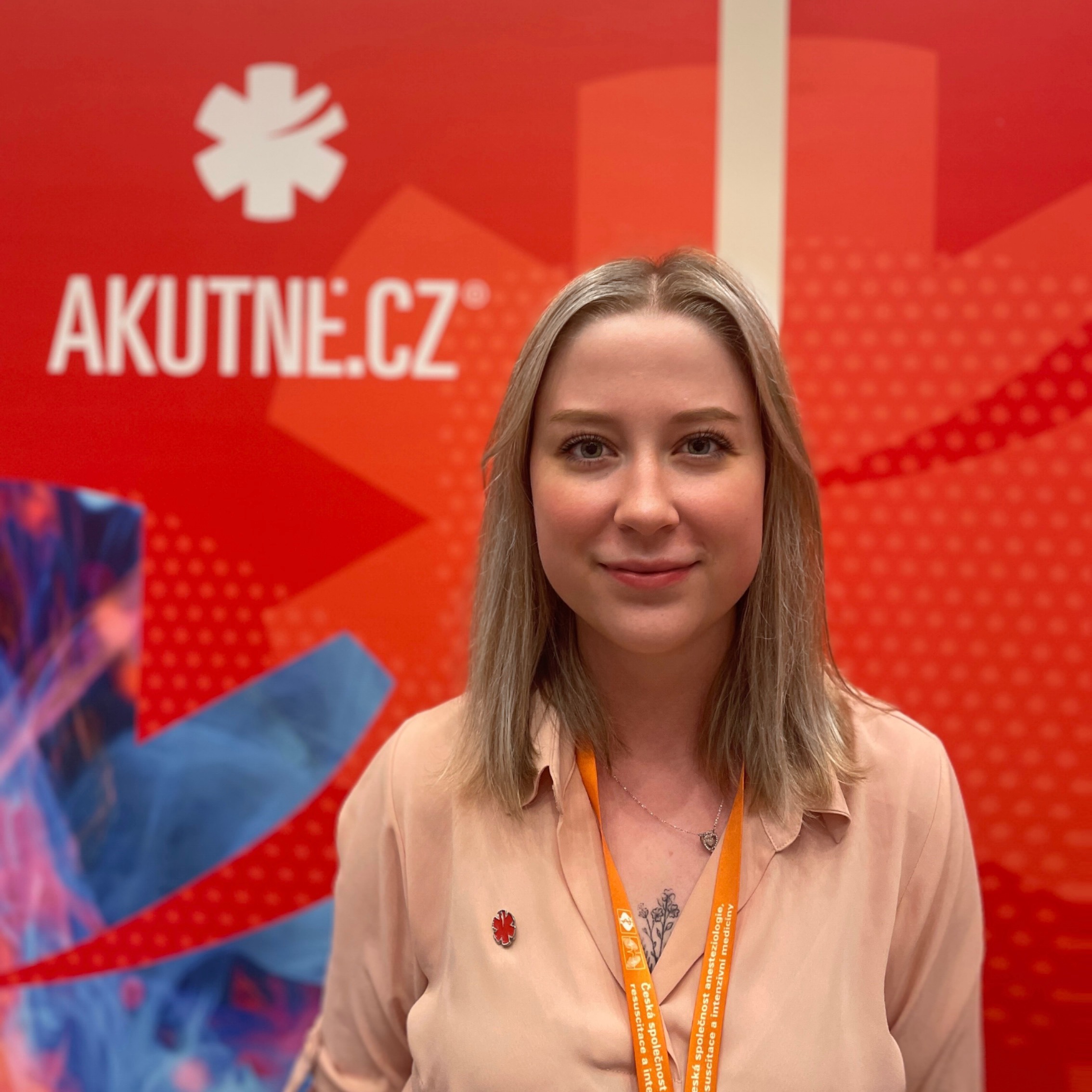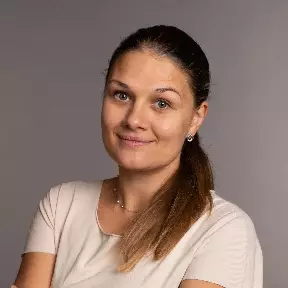Thursday
Marriage after 177 years
The XXIX. Congress of ČSARIM commenced with a lecture titled "Marriage after 177 years" by dr. Křikava (Brno) in the form of a panel discussion involving psychologist Mgr. Kalinová (Brno), dr. Harazim (Brno), dr. Ťoukálková (Brno), and dr. Krška (Prague). The metaphorical title reflected the relationship between surgeons and anesthesiologists, especially in the context of operating rooms. Mgr. Kalinová elaborated on the challenges in both professional and personal life arising from the complex "marriage" between surgeons and anesthesiologists. According to dr. Krška, conflicts could arise daily, and the majority of medical professionals (mostly anesthesiologists) voted for one major conflict per week. The discussion was enlivened by humorous videos illustrating common misunderstandings between these two fields. Conflicts primarily stemmed from the need to perform procedures quickly while ensuring the safety of anesthesia and the surgical process.
Technology in the operating room from the perspective of (patho)physiology
The second block of the day featured dr. Astapenko (Hradec Králové), introducing the first speaker, dr. Černý (Bratislava), discussing the physiology in the operating room. He focused on the crucial knowledge of oxygen delivery, especially emphasizing its significance in modern medicine. Dr. Astapenko then delved into microcirculation, explaining its physiological principles and highlighting the importance of researching fundamental principles. Dr. Hahn (Stockholm) introduced basic strategies in volumotherapy during surgeries, emphasizing the importance of hemodynamic monitoring for procedures lasting more than two hours. The focus shifted to new technologies and tools for airway management, presented by dr. Werner (Hradec Králové). He showcased advancements in securing airways, innovations in videolaryngoscopy, and the use of ultrasound in intubation. Additionally, he discussed artificial intelligence, noting its current limitations.
Patient after CPR/neurointensive care
The CPR-focused session, opened by dr. Černá Pařízková (Hradec Králové), featured two presentations by dr. Beneš. The first addressed the real benefits of sedation monitoring in intensive care patients, emphasizing the importance of sedation, the drawbacks of sedative drugs, and the significance of depth monitoring. The second presentation delved into defining ideal physiological targets post-successful CPR, exploring challenges and specific recommendations. Dr. Černá Pařízková's lecture, "Prognostication after CPR – Update 2023," highlighted predictors of clinical outcomes, neuroprognostication's role, and the importance of EEG monitoring. The session concluded with dr. Pokorná's (Prague) presentation on donors after circulatory death (DCD), detailing the process, successes, challenges, and the introduction of DCD into clinical practice in the Czech Republic.
Opening ceremony
The congress was inaugurated by dr. Černý (Bratislava), presenting the new ČSARIM committee and welcomed foreign guests, particularly colleagues from Slovakia. Dr. Kraus emphasized the committee's openness to collaborative problem-solving. Dr. Beneš was invited to announce publication awards for the year, acknowledging outstanding contributions from various professionals.
Safe anesthesia—possible or unattainable?
The block focused on safe anesthesia, opened by dr. Vymazal (Prague) who emphasized the crucial role of an anesthesiologist in ensuring safety. The first lecture highlighted inadequate communication, differences between original drugs and generics, and failure to recognize high-risk patients as significant threats to smooth anesthesia. Dr. Kocián's (Prague) lecture, "Minimally Invasive Colorectal Surgery or What an Anesthesiologist Should Know About a Surgeon's Work," delved into the world of surgical procedures, particularly robotic interventions, emphasizing the indispensable role of an anesthesiologist. The presentation showcased the elegance and gentleness of laparoscopic colorectal surgeries and stressed their importance for the future. Dr. Bláha's (Prague) lecture, "TIVA = Target-Controlled Infusion?," explored anesthetic topics with a focus on the TIVA concept. Guests elaborated on its advantages over inhalation anesthesia, addressing contraindications and risks. The final presentation by dr. Křikava (Brno) introduced "Pediatric TIVA - Easily and Safely!" explaining the principles of Target-Controlled Infusion (TCI) and the specifics of pediatric anesthesia, emphasizing the importance of using age-specific TCI models based on propofol pharmacokinetics.
Securing the airway in 100 different ways
Dr. Henlín presented military airway securing methods, notably using a nasal airway, deviating from the expected intubation tube. He briefly discussed the controversial topic of difficult airway existence. Dr. Brožek took the stage with "When you expect it not to work," delving into difficult airway issues and emphasizing the advantages of intubating conscious patients in certain situations. Dr. Otáhal (Prague) followed with his lecture, "When you don't expect it not to work." He highlighted the benefits of cricothyrotomy and cricothyroid puncture, providing practical tips and a video tutorial for several techniques. Special attention was given to the BACT technique as the preferred method, discussing differences between horizontal and vertical incisions. Lastly, dr. Křička (Fribourg, Switzerland) presented "The Swiss Way," comparing anesthesiology in the Czech Republic and Switzerland, discussing long-term career planning for young doctors and differences in practical anesthesia, including the presence of color-coded Flava carts for varying airway difficulty levels. He concluded with a comparison of working hours for young doctors in Switzerland and the Czech Republic.
The best in intensive care - MODS, nutrition, intoxication
Dr. Šrámek (Brno) opened the session, delving into MODS with a brief historical overview and the pathophysiology of the process. The discussion included phenotyping individual responses and the pursuit of personalized patient treatment. Dr. Matějovič (Plzeň) took over, focusing on nutrition in intensive care, addressing the current shift in nutritional strategies, drawbacks of aggressive nutrition therapy, and the challenges of monitoring nutrition post-ICU discharge. The final segment by dr. Balík (Prague) covered intoxication issues, emphasizing toxin elimination, the role of extended daily dialysis, particularly the advantage of high-flux filters, and highlighting ECMO's crucial therapeutic role in cardio-drug poisoning. He concluded with practical cases, stressing the need for early intervention by experienced intensivists, recognizing the limitations of lab results in intoxication therapy.
Critical airway
The session opened with dr. Votruba (Prague) and dr. Flaksa (Prague), a bronchologist-anesthesiologist duo. Dr. Votruba discussed tracheal stenoses, highlighting re-tracheostomy and cannulation longer than 30 days as the most significant risk factors. Dr. Šestáková (Prague) followed with a presentation on bronchological treatment options for complications after intrathoracic surgeries. She covered the management of prolonged air leakage, alveolopleural, and bronchopleural fistulas, emphasizing the importance of infection control and choosing the appropriate fistula closure method. Dr. Šimovič (Prague) then addressed massive endobronchial bleeding, emphasizing the high risk of asphyxiation due to the small dead space volume. He focused on diagnosis, advocating for CT angiography in stable patients and immediate bronchoscopy in unstable cases. Dr. Otáhal (Prague) continued with a lecture on bronchoscopy in patients with respiratory insufficiency, explaining its indications and significance in improving patient outcomes. Dr. Lukeš (Prague) concluded the block, emphasizing the LEMON scale in assessing airway risks. The method of securing the airway depends on the bronchoscopy indication, with a laryngeal mask commonly used for diagnostic procedures and a rigid tube for therapeutic interventions. Dr. Šestáková returned to present three interesting case studies at the end of the session.
Clinical Hematology for Anesthesiologists
The final afternoon session began with dr. Černý (Bratislava) discussing the boundaries of hematology. Dr. Horáček. (Prague) then explored anemia in the anesthesiology outpatient clinic, emphasizing its preoperative risks. Dr. Mazánek (Brno) highlighted that routine monitoring of anti-Xa activity during LMWH therapy is generally unnecessary. Dr. Pařízek (Prague) focused on FVIIa in obstetrics, noting recent NovoSeven® indications. Dr. Tylla (Prague) discussed the approach to patients treated with DOAC, emphasizing differences from warfarin. Dr. Černý returned to talk about Andexanet Alfa's role in managing bleeding complications post-DOAC use. The session closed with dr. Szabó (Bratislava) presenting preoperative tranexamic acid use in orthopedics, showcasing its impact on blood loss.
Friday
Review my case - SMAI
The Section of Young Anesthesiologists and Intensivists was opened by dr. Klincová (Brno) and welcomed the second moderator, dr. Mach (Nové Město na Moravě). The interactive block, titled "E.coli Revisited," began with dr. Nekvindová (Zlín) sharing a case involving tension pneumocephalus due to E.coli infection. She highlighted the importance of considering the patient as a whole and not just within one's specialization. Dr. Horejsek (Prague) then discussed challenges faced during a procedure involving stent graft placement, leading to a discussion on anterior spinal syndrome. Dr. Benešová (Plzeň) presented a case on recognizing grand mal seizures during general anesthesia, emphasizing the need for careful premedication selection. The block concluded with dr. Bartoš (Brno).
Bleeding in Ambulance, Emergency Department, and Operating Room
The next block, focusing on life-threatening bleeding, was initiated by dr. Bláha (Prague), who stressed the preventability of most deaths caused by life-threatening bleeding. Dr. Kolouch (Prague) discussed the importance of rapid control of bleeding in his lecture "Here's the EMS, We're on Site." And emphasized the need for fluid resuscitation and cautious use of fluids. Dr. Beneš (Plzeň) discussed the urgent physician's role in life-threatening bleeding. He outlined critical bleeding types, stressing the need for prompt surgical intervention. Emphasizing the challenges of intubation in the ER, he highlighted the importance of careful consideration and having a backup plan. Dr. Cibula (Prague) provided a surgeon's perspective on the importance of teamwork and cooperation in successful operations.
Position Matters!
The block on changes in patient positioning began with dr. Otáhal (Prague), followed by insights from dr. Mlček (Prague) on the physiology of positioning. Physiotherapist Chwalková (Ostrava) discussed rehabilitation, and dr. Beneš (Plzeň) focused on the hemodynamic impact of different patient positions. Dr. Otáhal concluded the block by discussing the use of positioning as a ventilation therapy.
Obstetric Analgesia - How I Do It
Dr. Bláha (Prague) opened the obstetric analgesia session, introducing the first speaker, dr. Štourač (Brno). The first lecture highlighted anesthesia practices in labor, referencing the OBAAMA-COV study with 3500+ participants. Mgr. Němcová (Prague), a midwife, discussed childbirth management principles and emphasized epidural analgesia as the primary choice of analgesia. She outlined its benefits, including pain relief, pelvic muscle relaxation, faster vaginal delivery, and improved uteroplacental perfusion. Dr. Nosková (Prague) presented types of peripartum analgesia and guiding principles. Dr. Seidlová (Brno) focused on complications in obstetric analgesia, addressing indications for epidural use and pharmacological solutions for different patient conditions. The final lecture by dr. Koucký (Prague) covered postpartum care and facilitating a speedy return home for new mothers.
The End of Epidural Analgesia in the Czech Republic?
Dr. Gabrhelík (Zlín) introduced the PRO/CON discussion on epidural analgesia, emphasizing its primary role and the need for anesthesiologists to master this skill. Dr. Jelínek (Brno) argued in favor of ending epidural analgesia, aligning techniques with surgical advancements like minimally invasive surgery and promoting multimodal analgesia. Dr. Čundrle (Brno) presented arguments supporting the continued use of epidural analgesia, addressing its benefits in various surgical fields and highlighting its role in reducing opioid use. Despite differing views, the consensus was that epidural analgesia maintains its place alongside peripheral blocks, and future challenges include ensuring adequate training as its use declines.
Pediatric Anesthesia 1
The pediatric anesthesia block commenced with a warm welcome from dr. Štourač (Brno) and an introduction of co-moderator dr. Vymazal (Prague). Dr. Fabián (Brno) then presented on Rapid Sequence Intubation (RSI) in newborns, emphasizing the importance of securing IV access, recommending the use of EMLA cream. Dr. Biskupová (Prague) discussed the risks of anesthesia in children with mucopolysaccharidosis, highlighting challenges such as a large tongue, tracheomalacia, chest deformities, and atlanto-occipital instability. Dr. Bönischová (Brno) explored the necessity of monitoring anesthesia depth in children, advocating for instrument-based methods during TIVA + NMBA. Stressing the lack of evidence-based recommendations for EEG use in pediatric anesthesia, she concluded that relying solely on vital parameter changes for assessing depth is unreliable. Dr. Vrabcová (Prague) wrapped up the first pediatric anesthesia block, detailing the specifics of pediatric anesthesia, including preoperative preparation, suitable anesthetic approaches, and material utilization. She addressed common perioperative complications and underscored the importance of meticulous postoperative care for children.
Patient Admission from the Perspective of Emergency Medical Services, Emergency Department, and Intensive Care
Dr. Máca (Ostrava) opened one of the last blocks of the Friday program, welcoming dr. Gřegoř (Ostrava). Dr. Gřegoř, as the director of Emergency Medical Services, humorously navigated through the responsibilities of emergency services, clarifying legal ambiguities and common misconceptions. He shared the positive note that nearly every other patient is successfully resuscitated. Dr. Kutěj (Olomouc) continued with a lecture on the role of the Emergency Department as a rational gateway for most acute conditions. Exploring organizational models with inspiration from the military, he focused on the FNOL department, offering detailed insights. Dr. Sklienka (Ostrava) concluded the section with a touch of humor, transitioning into the topic of criteria for admission to the intensive care unit from an intensivist's perspective. He emphasized medical ethics, patient autonomy in decision-making, and, despite the gravity of the subject, lightened the atmosphere with witty remarks, concluding the block on a positive note.
Pediatric Anesthesia 2
In the final friday block, moderated by dr. Štourač and dr. Vymazal, they continued from the previous Pediatric Anesthesia I session. Dr. Hubálek (Prague) presented three case studies of patients with malignant hyperthermia, emphasizing the challenge of its variable course. Dr. Klincová (Brno) addressed "Malignant Hyperthermia up to date," covering the disease, its pathophysiology, and the difficulty of detecting its genetic mutation. She highlighted symptoms like increased capnometry, trismus, and myoglobinuria, along with the necessity of prompt action and transition to Total Intravenous Anesthesia (TIVA) with dantrolene administration. Dr. Ťoukálková (Brno) discussed regional analgesia in children, presenting a study on recent regional blocks. Dr. Kolek (Brno) concluded the series, focusing on pathological conditions arising from Streptococcus pyogenes superinfection after influenza and RS virus. He noted a significant rise in pediatric hospitalizations post-SARS-COV-2 pandemic and emphasized the importance of glucocorticoid administration, sharing case studies illustrating disease severity and successful treatment with Anakinra in a patient with mediastinitis.
Posters
This year, the medical poster section was led by dr. Beneš (Plzeň) and dr. Astapenko (Hradec Králové).
Dr. Gimunová (Brno) explored the benefits and risks of tamoxifen treatment during surgeries. Dr. Pokorná (Prague) addressed the organ donor shortage, while Dr. Skříšovská's (Brno) winning poster investigated ventilation effectiveness during pediatric CPR. Dr. Kalina presented a study on the advantages of ultrasound-assisted peripheral venous acces in the operating room, securing the third spot. Dr. Dominik (Brno) focused on early sepsis diagnosis, introducing biomarkers. Dr. Horejsek (Prague) predicted fluid responsiveness in early postoperative periods for cardiac surgical patients, securing the second place. Dr. Fabián (Brno) discussed the impact of HFNO preoxygenation on preintubation desaturation in children, deeming it a possible and safe approach. Dr. Vrbica (Brno) closed the poster section with a study on fibrinogen administration in prehospital care for polytrauma patients, sparking a fruitful discussion and raising new questions in the respective fields. Congratulations to Dr. Skříšovská for her first-place achievement.
Saturday
No child is dead until warm and dead
Dr. Truhlář (Hradec Králové) initiated the discussion on the block's importance, and dr. Kubalová (Zlín) highlighted key facts about accidental hypothermia, underscoring the insulating role of snow. Dr. Gretz (Hradec Králové) shared case recordings illustrating how emergency responders and doctors handled hypothermia in children. Subsequently, dr. Kratochvíl (Brno) delved into the specifics of ECMO, emphasizing its common usage in observed cardiac arrests, intoxications, or hypothermia cases. Dr. Djakow (Brno) explored advancements in post-resuscitation care for pediatric patients, shedding light on the challenge of limited long-term outcome monitoring in the Czech Republic.
What would you take to a deserted island if you were the only doctor?
The final session featured a compelling panel discussion led by dr. Henlín. Various clinical cases, including chest trauma, burns, and vascular injuries, were presented and thoroughly discussed. Each case provided unique insights, such as dr. Kušíková's (Banská Bystrica) account of a burned child during a humanitarian mission, highlighting logistical challenges. Dr. Rybka shared a story set in the high-altitude environment of Antarctica, emphasizing the isolation of the research group for nine months and the consequent limitations in both material and logistical aspects. Dr. Hána's (Prague) case focused on vascular injuries in the groin area, stressing the importance of strategic management with limited resources. The discussion concluded with dr. Štětina's (Hradec Králové) presentation on a case of cranial trauma, adding depth to the exploration of unconventional scenarios in intensive medicine.
Closing ceremony
The congress concluded with dr. Štourač (Brno), dr. Beneš (Plzeň), and dr. Bláha (Prague) awarding the authors of outstanding posters, specifically acknowledging dr. Skříšovská (Brno) and dr. Tégl (Plzeň). They summarized the event, highlighting the historically high attendance, diverse workshops, and the continually increasing quality of the professional program. The audience was invited to the ČSARIM 2024 congress in Brno. As a symbolic end to these three days, a video was presented, summarizing the history, milestones, and significant figures in the field of Acute and Internal Medicine in the Czech Republic. The reporting team sincerely bids farewell to readers, hoping to meet again at AKUTNĚ.CZ!







